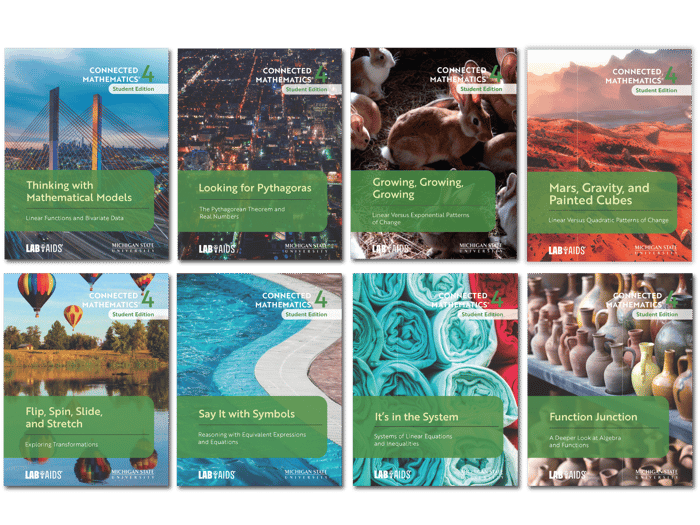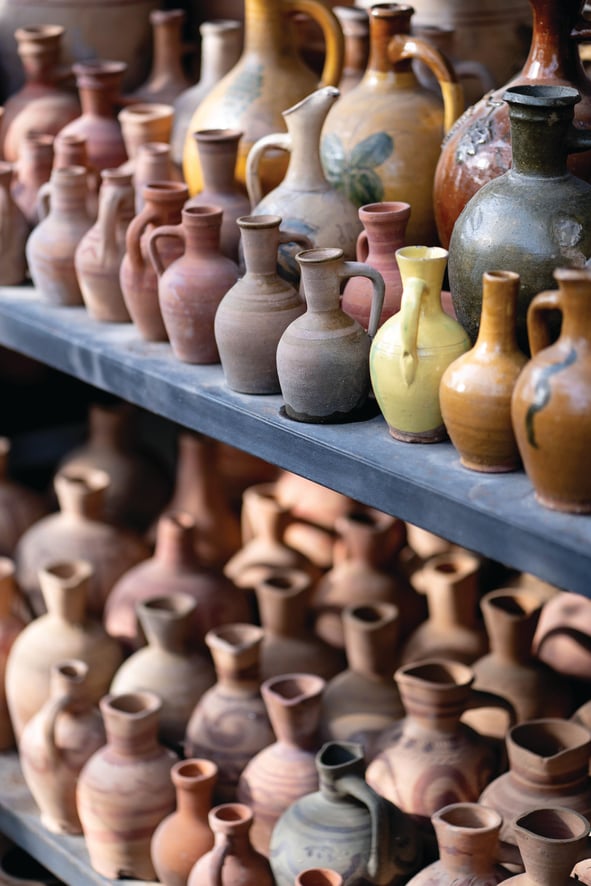8th Grade & Algebra | Connected Mathematics® 4

Connected Mathematics® 4 (Phillips et al., 2025) is a coherent, problem-based curriculum that promotes an inquiry-based teaching-learning classroom environment. Important mathematical ideas are identified, and the essential understandings of these ideas are embedded in a carefully sequenced set of contextual problems. This means that students and teachers start with a problem and together they work to solve it. An important part of the problem-solving process is a discussion on
- the strategies students used to solve the problem,
- the embedded or encoded mathematical understandings in the problem situation, and
- how these understandings build on prior knowledge.
The curriculum helps students grow in their ability to reason effectively with information represented in verbal, numeric, graphic, and symbolic forms and to move flexibly among these representations to produce fluency in both conceptual and procedural knowledge.
Grade 8 Mathematical Focus: Students focus on formalizing patterns of change, relationships, and transformations.
Details at a Glance
- 138 periods
- 32 Investigations
- Includes digital resources
- Developed in partnership with Michigan State University
- Includes assessment
- Problem-based
- Includes support for multilingual learners
- Embedded differentiation
- Fosters student collaboration
- Student self-assessment and reflection
- Integrated Algebra I/High School Course I standards
Student Access
-
#CMP8-4SE
-
#CMP8-4OLSP-6
Teacher Access
-
#CMP8-4TE
-
#CMP8-4OLTP-6
Additional Curriculum Materials
-
#CMP8-CMK-4
Scope & Sequence
Content in 8th Grade & Algebra | Connected Mathematics® 4 is organized into 8 units, as follows:

Unit 1 | Thinking with Mathematical Models
Linear Functions and Bivariate Data
In this unit, students explore linear and nonlinear relationships or functions and how they are used to model real-life phenomena and solve problems. At the end of this investigation, students ask themselves: What are the characteristics of linear functions? How might we use what we know about linear functions to model a situation? What other kinds of models have we explored?
20 Days | 4 Investigations

Unit 2 | Looking for Pythagoras
The Pythagorean Theorum and Real Numbers
In this unit, students explore the Pythagorean Theorem and how it can be used to solve problems and motivate the need for numbers that are not rational. At the end of this investigation, students ask themselves: What do we know about the Pythagorean Theorem? What do we know
about real numbers?
21 Days | 4 Investigations

Unit 3 | Growing, Growing, Growing
Linear Versus Exponential Patterns of Change
In this unit, students explore an important type of nonlinear function, exponential functions. At the end of this investigation, students ask themselves: What do we know about exponential functions and exponential expressions? How do exponential functions compare to linear functions?
19 Days | 4 Investigations

Unit 4 | Mars, Gravity, and Painted Cubes
Linear Versus Quadratic Patterns of Change
In this unit, students explore quadratic functions and equivalent expressions and how they can be used to solve problems and make predictions. At the end of this investigation, students ask themselves: What do we know about quadratic functions and equivalent expressions?
18 Days | 4 Investigations

Unit 5 | Flip, Spin, Slide, and Stretch
Exploring Transformations
In this unit, students use transformations to move one figure on to its image. At the end of this investigation, students ask themselves: What do we know about transformations? How do they affect the shape of the figure?
21 Days | 4 Investigations

Unit 6 | Say It with Symbols
Reasoning with Equivalent Expressions and Equations
In this unit, students explore equivalent expressions to represent a quantity in a relationship. At the end of this investigation, students ask themselves: What do we know about equivalent expressions or equivalent equations? How is this information useful in solving problems?
19 Days | 4 Investigations

Unit 7 | It's in the System
Systems of Linear Equations and Inequalities
In this unit, students look at solutions to linear equations and inequalities and systems of linear equations and inequalities. At the end of this investigation, students ask themselves: What do we know about finding solutions to equations and inequalities and pairs of linear equations and inequalities?
9 Days | 4 Investigations

Unit 8 | Function Junction
A Deeper Look at Algebra and Functions
The major focus of the unit is to deepen students’ understanding of functions. Investigation 1 deepens understanding of the domain and range of functions and the symbolic f(x) notation for expressing relationships among the variables in special families of functions.
11 Days | 4 Investigations
Program Components
Lab-Aids programs combine components to make a system for learning. Learn more about each of the components below.
What are the options for teacher access?
In Print
A print set of eight Teacher Editions and A Guide to Connected Mathematics 4 (Teacher Resources). Full-color pages are set in an organized and tabbed, three-ring binder making it easy to navigate and personalize with highlighting, annotations, rearrangements, and insertions.
Online Teacher Portal Access
Online Teacher Portal access for one teacher for 6 years and includes: all grade-level Teacher Editions, the Guide (Teacher Resources), and all grade-level Student Editions. Teachers can create groups; assign ACE, reflection questions and assessments; enable accommodations; and communicate with students. Numerous tools include Desmos graphing calculator, MathType, highlighter, and line reader.
What are the options for student access?
In Print
A print set of eight Student Editions. Full-color pages include easy navigation throughout the content and include hole-punched softcover binding for easy integration into a math binder. Nonconsummable.
Online Student Portal Access
Access to Online Student Portal for 6 years and includes the digital Student Edition. Numerous embedded tools include: ReadSpeaker, Desmos graphing calculator, MathType, line reader, highlighter, and notepad. Complete problems and assessments online.
Additional Curriculum Materials
Explore complementary materials that enhance instruction and save valuable prep time. These resources are optional but designed to enrich the learning experience beyond the core curriculum.
